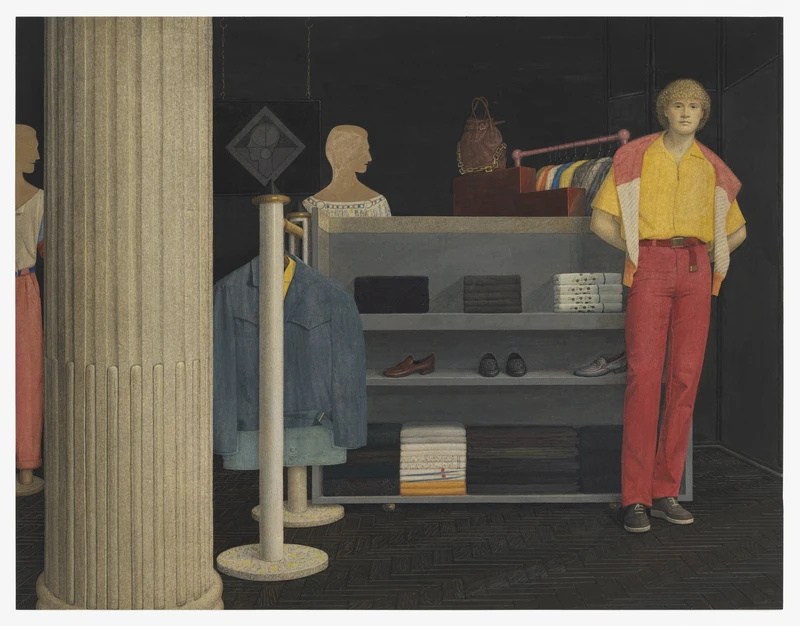Graham Little


b. 1972, United Kingdom
Scottish painter, born 1972
In the mid-1980s, a copy of Vogue found its way into the home of Graham Little (b. 1972, Dundee, UK) in Dundee, Scotland, by way of a neighbour who was gifting the magazine to the artist’s sister. As curator and writer Laura Smith recounts: ‘Little, already accomplished with a colour pencil, became fascinated by the powerful ‘80s imagery of self-assured, emancipated women’. From that moment, ‘[he] stopped drawing onions and branches and started drawing perfume adverts.’1
In the decades since, Little has expanded this fascination, producing a delicate body of gouache and pencil vignettes that situate solitary figures within intricately designed interior spaces. His meticulously built compositions revel in the texture, pattern and choreography of fashion advertising, while alluding to the aesthetic sensibilities and compositional strategies of Modernist figuration and the Old Masters. But while Little’s interest in perceived beauty (or the construction thereof) cannot be underplayed, his domestic chambers are often characterised by the psychological blemishes that beauty cannot mask: distraction, disinterest and distance; emptiness cloaked in aesthetic sheen.
The majority of Little’s sitters are young women and men sourced from 1980s issues of Vogue, Harper’s Bazaar and, most frequently, the German style magazine Burda Moden. In stark contrast to the dominant mode of contemporary fashion photography, in which femininity is framed as hyper-sexualised and highly unattainable, these early editorials eschew flirtation and allure in favour of markedly mundane situations. In Alpine Lady (2009–10), Rose Lady (2010) and Untitled (Office) (2013), women speak on the phone; in Leopard Lady (2010), Pink Stocking Lady (2010) and Daffodil Shoe Lady (2010), women smoke. The protagonist of Untitled (Athlete) (2019) stretches his back in an open window. ‘For me’, says Little, ‘that is the most interesting part of painting. I find it amazing that humans can make something that’s magical from something quite plain.’2 There is beauty to be found in spite of the mundanity – or as a direct result of it.
Little’s work is a slow and considered attempt to process this beauty. (Individual works often take years to complete.) It is a protracted negotiation of the relationship between the seer and the seen, one that indulges in aesthetics while remaining cautious of their appeal. As critic Martin Herbert writes of Little’s work: ‘Beauty without flaws is unnerving. […] The loveliness of another can’t be possessed anyway, and is of course temporary. Does beauty, in the world, do more harm than good?’3 As tender as they are tentative, as intimate as they are unattainable, Little’s painted vignettes are calculated attempts to resolve this dichotomy via a momentary embodiment of it. ‘I think the work allows me to process the difficulty of beauty’, Little notes, ‘along with the unease of being masculine’.4
In this, Little’s work can be seen as an attempt to manifest order and reason within a disorderly and unreasonable world, to reside within it, to control it. Just as the measured process of constructing a narrative for his sitters demonstrates a belief in empathy and understanding, so too does the meticulousness of his interior architectures suggest a deep need to organise. (‘His figures are positioned like chess pieces’, Smith observes.5) There is a frustration inherent to this, a feeling that everything is not in its right place. This sense of artistic or experiential insufficiency is broached most directly in Little’s paintings of roadkill: Untitled (Fox) (2017) and Untitled (Squirrel) (2021). While the sense of an ending introduced by these post-mortem studies might appear incongruous, its unseen presence can be felt beneath each of the domestic vignettes. Beauty might conceal, appeal, seduce, but it cannot rescue. ‘Whereas the images of women are a way of processing what I’m thinking and feeling’, Little says, ‘the fox is more of an actual visceral scream’.6
Little’s compositions can be read as ‘otherworldly’: anachronistic and quietly closed, at a distance from the dullness of contemporary life. (In Untitled (Balcony), 2016, a woman waters a perfect halo of strawberries as a cold blue lake becomes the sky.) But it cannot be said that this work is divorced from reality. In fact, Little’s paintings represent a nostalgic yet wholly necessary reinvestment in the gentle, intimate details that make contemporary life what it is. ‘When Little’s practice is at its most serene’, writes Herbert, ‘it seems to ask why there can’t be more delicacy in the world; that, even in our world of abundance and access, there are things we’ve lost. Kindness, say. Humanity, say.’7
1.Laura Smith, ‘Introduction’, Inside the water sleep (London: Alison Jacques Gallery, 2019), p.21
2.Graham Little in conversation with Alison Jacques Gallery, 12 February 2021
3.Martin Herbert, ‘The Beautiful Ones’, Inside the water sleep (London: Alison Jacques Gallery, 2019), p.55
4.Little, 2021
5.Smith, p.21
6.Little, 2021
7.Herbert, p.58